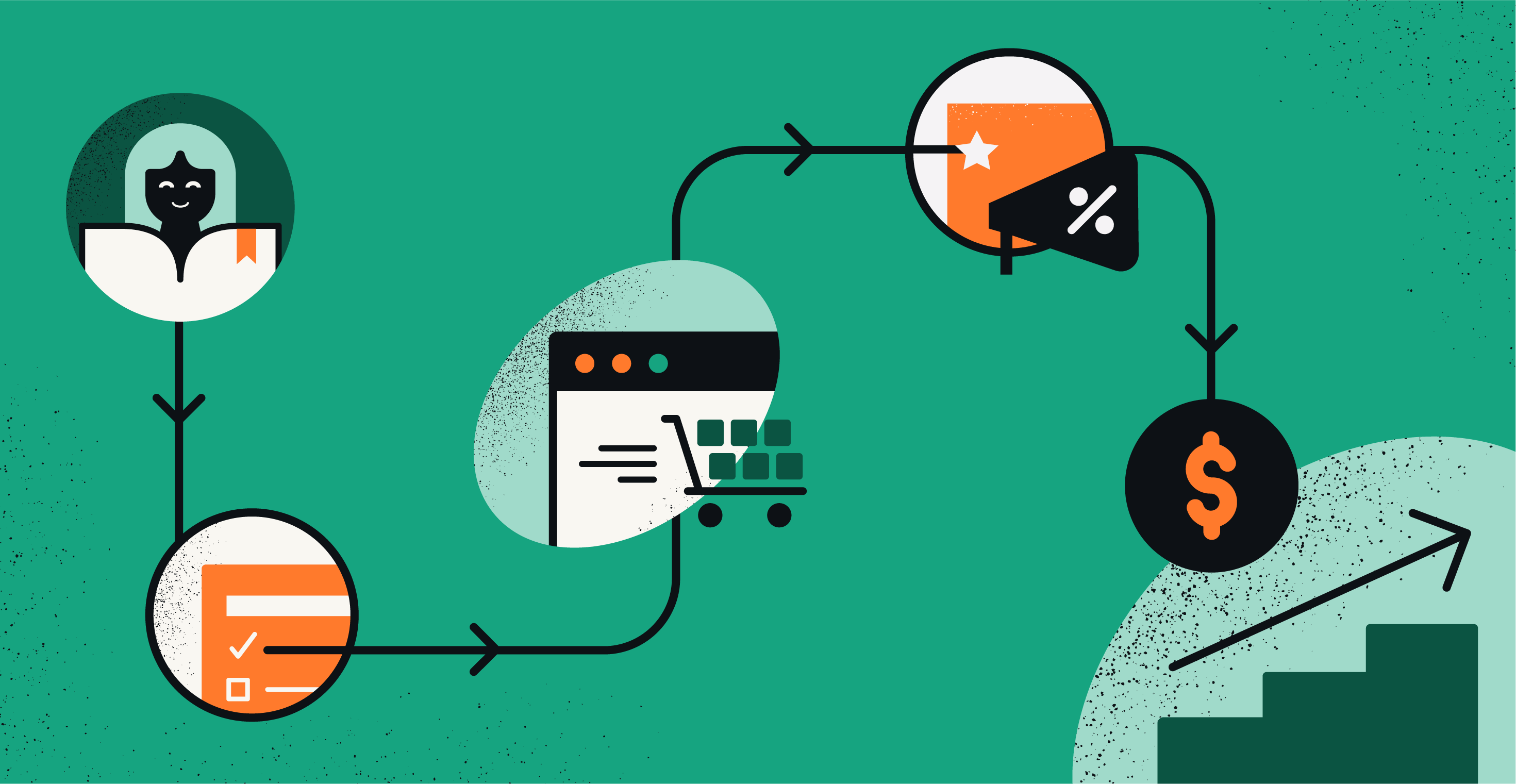The Advantages of Launching a Subscription Box Business
There are a wide variety of benefits for entrepreneurs starting subscription box businesses. Here are five important ones:
✅ Recurring revenue: This model generates a recurring and stable income stream.
✅ Scalability: Once you have a successful service with a solid subscription base, you can easily increase your subscriber numbers through marketing and referrals.
✅ Inventory management: A subscription model means you can accurately predict your inventory needs, which can help you manage costs more efficiently.
✅ Higher lifetime value: Because customers spend more through a recurring subscription, the revenue you generate per customer is higher than it would be in other business models.
✅ Higher multiples: Due to the ongoing income of subscription box services, investors and buyers will likely value it with a higher multiple when you sell shares or exit your business.
The right subscription business model offers a range of benefits to entrepreneurs who want steady revenue, predictable growth, and stronger customer relationships.
If the advantages of subscription business models sound good, you’re probably wondering how to start a subscription box business.
Let’s dive in and get started on your custom box. We’ve broken it down into an easy, five-step process:
Step 1: Choose Your Subscription Box
The quick version: Your idea is the foundation of your business.
The first thing you need to do is decide what type of subscription box you will sell. You can choose one of the more popular subscription box categories or select something unique.
🎁 Popular subscription box niches
Your first option is to select items that are already popular, thanks to existing subscription boxes. The graph below shows the most popular types of subscription boxes:
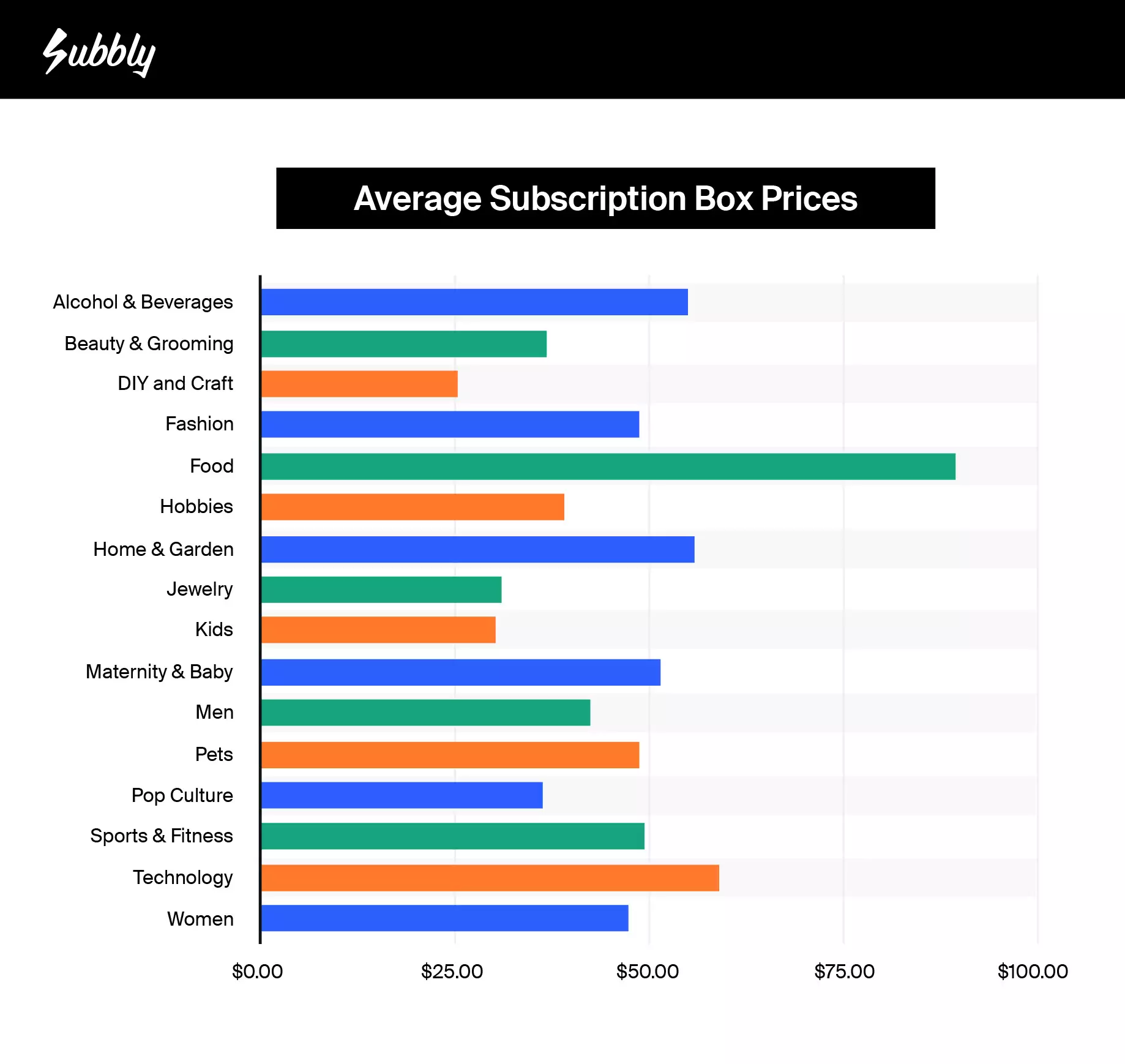
If you choose a popular category, the challenge you face is that the market is already saturated.
For example, there are hundreds of food and meal kit boxes already out there.
This means you may have a harder time competing with other businesses for subscribers. This is where you may want to lower the price of your box to entice new subscribers.
On the upside, if you choose a popular type of box, it should be relatively easy and affordable to source products to include. For example, if you choose beauty, you can buy these items from wholesale suppliers at a relatively low price.
🎯 Specific subscription box niches
There are several benefits of niching down and curating a truly unique box.
Firstly, you won’t be competing with a massive market to sell your boxes as there’ll likely only be a few available in your niche. You’ll also be able to charge more per box because subscribers can’t find these products as part of a subscription elsewhere.
Additionally, although the demand for your products may be lower due to their specificity, you’ll have access to an untapped audience to sell to.
However, the downside to choosing niche market products to include in your box is that these items could be more expensive to source.
The best niche subscription boxes are those that are based on your own passions or needs. You can directly translate this into the products you offer in your boxes.
For example, if caring for your dog is extremely important to you, this can help you choose products for your pet-related box that other dog owners will appreciate.
🏆 Understanding your competitors
Whether you’re going with a more popular type of subscription box or choosing a highly specific niche, you need to know who your competitors are.
Without knowing who you’re competing against, how will you ensure subscribers choose your product over a competitor?
Spend some time researching the competitors that are already selling your idea and find out:
- How many boxes you’re competing with?
- What do these subscription boxes offer, and at what price?
From there, you can start thinking about how you can differentiate your subscription box from your competitors to stand out.
Step 2: Start Your Planning
The quick version: Leave no stone unturned when it comes to planning.
Once you’ve chosen a model, it’s time to move on to the planning phase of your own subscription business.
Behind every successful launch is a solid plan. It’s a key part of building a strong foundation for success.
If you’re starting a new business idea from scratch, keep reading. Or you can check out our guide to adding subscriptions to an existing business.
1️⃣ Creating a business plan
All successful businesses start with a comprehensive plan. Here’s an overview of the key elements of any solid subscription business plan:
An executive summary
This is the introduction to your business plan, and it includes your business name, mission statement, a description of your offering, and an overview of all the following sections. It’s easiest to write this after you’ve finished all the other steps.
Problem and solution
You need to be clear about the exact problems that your subscription box services solve for your target customers.
This is the foundation you need for your promotional and marketing efforts. Being able to solve a customer’s pain points is a fast way to sell your subscription boxes as you’re generating a demand.
Your target audience
You need to spend time plotting out your ideal customer profile (ICP). Who is your audience? You won’t be able to land subscribers without knowing exactly who they are.
Create a breakdown that includes your ICP’s age, location, income bracket, education, profession, lifestyle, and any other relevant demographics.
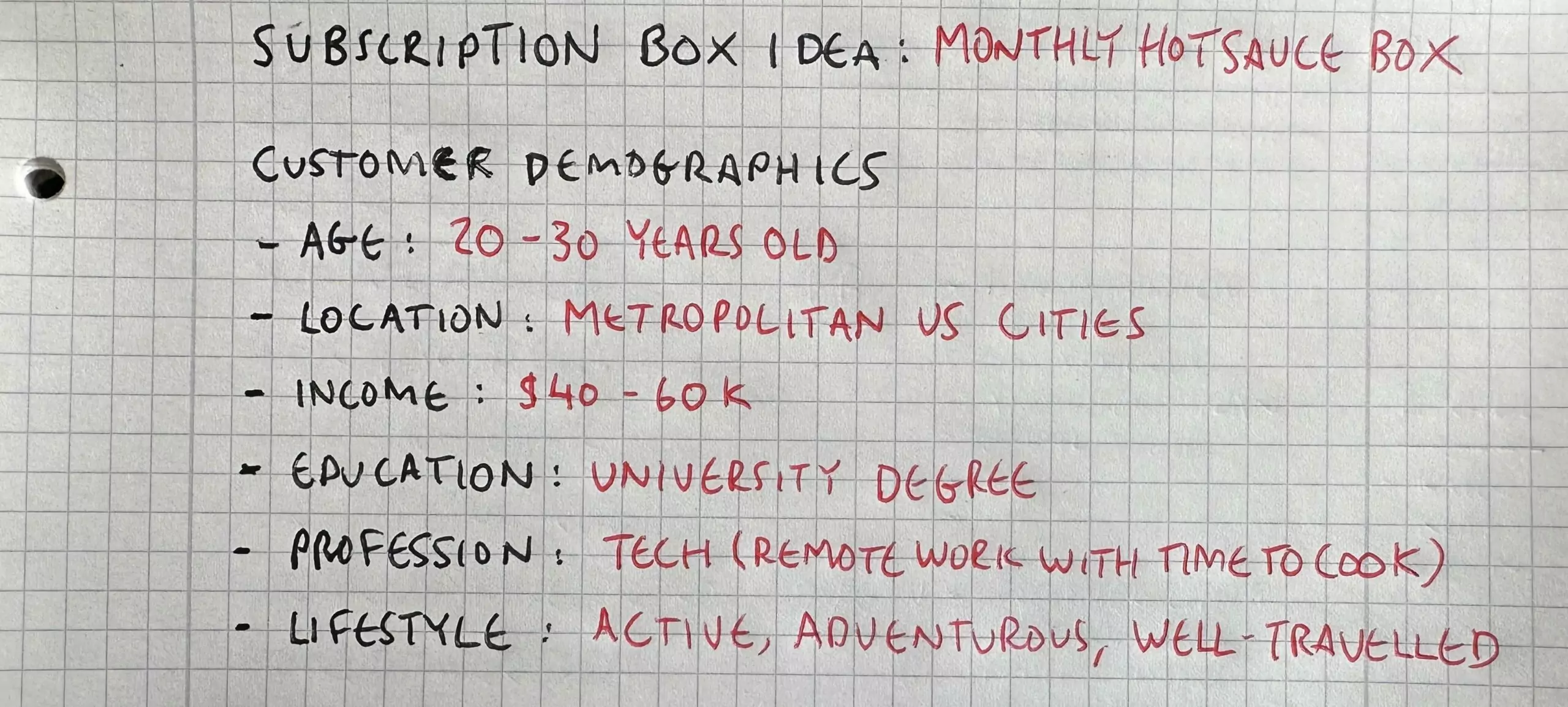
Your value proposition
A value proposition is typically a short statement that describes the value of your product or services, why people need it, and how it differs from your competitors.
This is the backbone of your marketing messaging and will inform how you promote your box.
A competitor analysis
Now that you know who your target audience is and how you can help them, it’s time to find other subscription services that offer a similar product.
Next, you need to analyze how successfully they’re selling their subscription box and what you can do better.
Pricing strategy
It’s a good idea to start with a cost breakdown of everything involved in creating and delivering your subscription box. This includes:
- The cost of goods sold (COGS).
- Packing costs.
- Shipping and handling costs.
- Transaction fees.
Having a clear overview of your costs will inform how you price your subscription box to cover all your expenses and make a profit. We’ll tell you more about pricing your subscription boxes later in this article.
A sales and marketing framework
You’ll need to identify the most important marketing channels to promote your offering, from search engine optimization (SEO) to email marketing.
You may also want to consider influencer marketing and initiatives to encourage the creation of user-generated content.
Later in this article, we’ll discuss how you can effectively market your new subscription box business.
Your team
Whether you’re running your business solo, have a full-time team, or are somewhere in the middle, make sure you detail all the people involved in your operation and what their roles are.
It might be helpful to use your business plan to outline what the key performance indicators (KPIs) are going to be for each person within your business.
Potential risks
As explained above, regardless of which business model you choose, there are risks and challenges involved.
Creating a business plan will help you consider these risks and what your strategy will be should things not go as planned.
For example, retaining subscribers can be challenging. How are you going to handle things when people unsubscribe to your box?
Your financial plan
A business plan is also an opportunity to create a financial outline. Your plan should include:
- Your sales and revenue forecasts.
- Expenses.
- A cash flow statement.
- A break-even analysis.
- Your tax breakdown.

Source: Subbly competitor benchmarking
2️⃣ Sourcing products for subscription boxes
Once you have a business plan in place, it’s time to think about how you’re going to source products for your subscription. Here’s what you need to plan for:
What are you going to sell?
To get a solid grip on your product procurement strategy, find out what your target market wants.
What stories will resonate with them, and what can you do to improve existing opportunities in your niche?
Where are you going to find items?
Where are you going to find these products? From Etsy to eBay and even Instagram, there are plenty of places for you to find high-quality suppliers for your subscription products.
💡 Get InspiredIf you’ve decided on the general subscription box theme you’re going for and are looking for some inspiration, browse through some of our favorite examples of subscription box ideas.
3️⃣ Considering your product packaging
The physical packaging of your subscription box is important for two reasons.
First, your packaging directly reflects your brand’s attention to detail. Keeping everything aligned with your brand identity is key. The unboxing experience is a particularly important touchpoint in this regard – more on this later.
Secondly, the quality of your packaging will affect the condition your products will arrive in when they’re delivered.
You may want to consider custom packaging as a way to showcase your brand and ensure that everything gets to its destination intact and in its original condition.
4️⃣ Pricing your subscription offering
Pricing your subscription box service is tricky. It’s more than just picking numbers and hoping they work.
You need to find a balance that attracts potential customers and motivates them to subscribe.
Here are three important steps to consider when setting your prices:
1. Choose your pricing model
Start by choosing a pricing model that suits your business. Here are two to consider:
🔒 Fixed pricing: This kind of pricing means you’ll have one box type with a predefined selection of products at a fixed price, often charged on a monthly subscription fee basis.
It’s the easiest pricing model to start with and gives you more time to focus on other important early-stage aspects of your business, like finding new customers.
Here’s what setting up fixed pricing looks like on Subbly:

📊 Tiered pricing: Tiered pricing means you’ll offer multiple types of subscription boxes with different selections of products at varying price points.
While this is a bit more complex to set up and manage, tiered pricing is a great way to meet a diverse range of needs and cater to a wider range of customers.
2. Set up your signup flow
You should also customize the signup experience for your customers to make it more engaging.
Take BusterBox, for example. Before their new customers reach the checkout, they ask five simple questions to personalize each subscription box.
BusterBox delivers healthy treats and toys for dogs, and they understand the value of making each box feel special.
They start by asking for your dog’s name, breed, and birthday. Then, throughout the process, they refer to your dog by name, adding a personal touch.
For instance, if your dog is a Labrador named Pongo, and you’re at step five in their signup flow where they suggest adding an extra treat, you’d see a message like this:
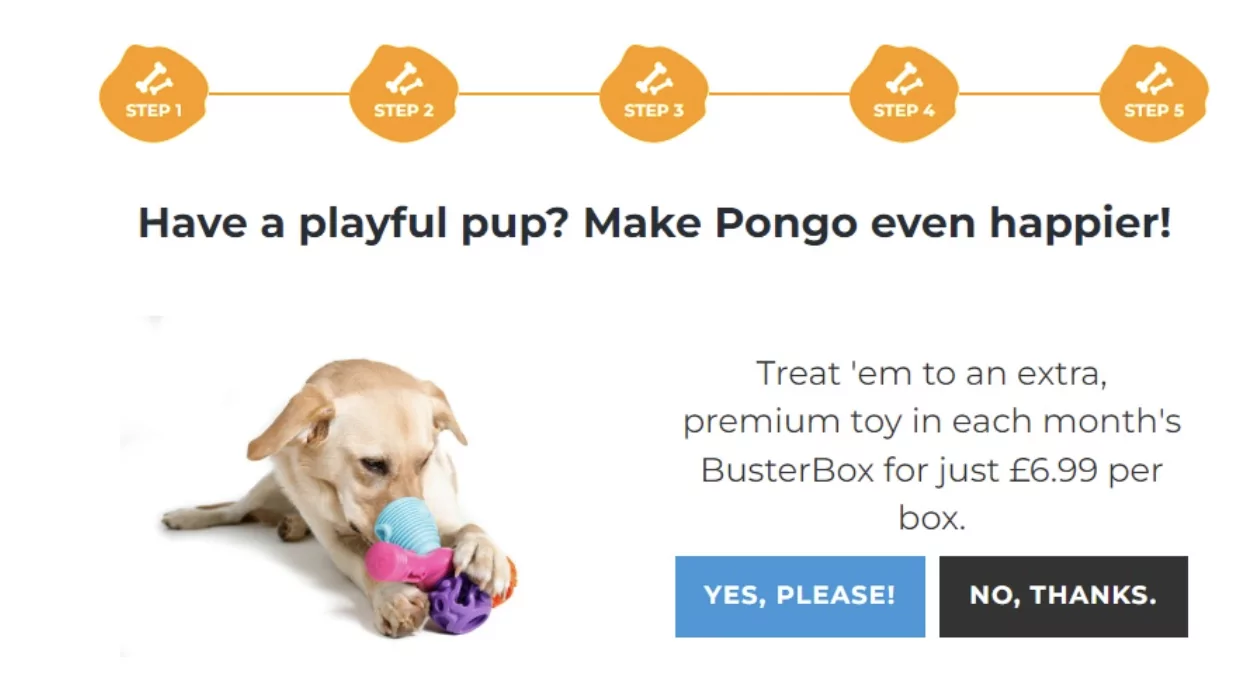
Having a signup flow that matches your brand can make or break your subscription business.
A well-designed flow not only reflects your brand’s personality but also keeps customers engaged, making them more likely to complete their purchase.
3. Use SKUs to adjust pricing
Stock-keeping units (SKUs) help you manage inventory, adjust pricing for specific product tiers, and gain insights into which subscriptions are most popular.
Let’s say you’re offering a skincare subscription box with a different number of products in each tier. Each subscription box will be assigned a unique SKU:
- Basic Box: SKU – SK-BB001 (Includes two products for $25)
- Premium Box: SKU – SK-PB002 (Includes three products for $40)
- Luxury Box: SKU – SK-LB003 (Includes five products for $60)
If you notice that new customers are increasingly choosing the Premium Box over the Luxury Box, you can adjust the price of the Luxury Box by simply updating its SKU.
For example, you could offer a 10% discount to make it more appealing without affecting the pricing of other tiers.
This is how you would set up tiered pricing for your subscription business model on Subbly:

In terms of margin, try to aim for around 50%.
5️⃣ Setting your goals
Now is the time to determine what the main goals for your business are going to be. If you want to run a successful business, your goals should be:
- Landing conversions: This is turning prospective customers into paying subscribers.
- Retaining your customers long-term: It’s important to retain your customers by keeping them happy. Acquiring new subscribers is far more expensive than pleasing your existing customers.
- Focusing on customer experience: Deliver the perfect customer experience to delight your subscribers. This experience starts with them discovering your product and extends to them receiving their box.
- Becoming an everyday product or service in households: This is how you lower customer churn and ensure your subscription box is always in demand.
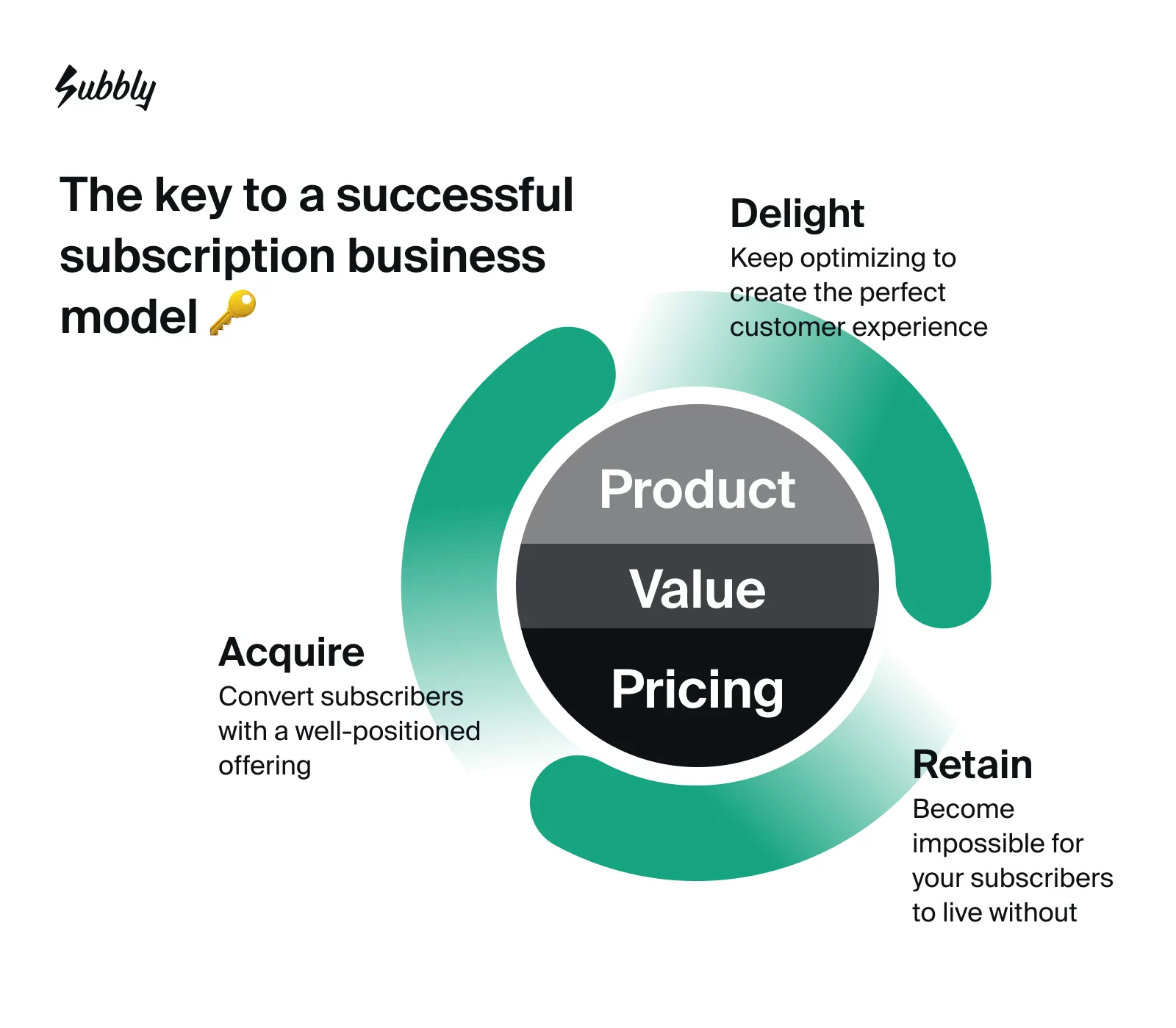
Successfully selling subscriptions involves finding the perfect balance between product, value, and pricing.
Once you’ve achieved these objectives, you’ll be able to scale your service exponentially and get the ongoing income you need for a thriving subscription business.
Step 3: Set Up Your Operational Framework
The quick version: Start things off on the right foot when it comes to the e-commerce platform you choose, website creation, shipping, and billing.
The next key step to starting a subscription box business is setting up your operations.
This entails everything from choosing a subscription box platform, setting up a website and online store, and planning logistics around customer convenience.
The more thought you put into how you set all this up, the easier it’ll be to scale once your loyal customer base has started to grow.
Remember, it’s best to use a platform designed for your business model. Check out the differences between different subscription e-commerce solutions to help make your choice.
💻 Choose an e-commerce platform
Simplicity is the main thing you should look for in a subscription e-commerce platform. Of course, it should also be designed for your unique model, but ensure that the platform you choose:
- Is built to scale and doesn’t charge you per subscriber.
- Is secure, reliable, and frequently updated.
- Allows you to do as much as possible in one place.
Be cautious of e-commerce platforms that lack built-in features to manage recurring payments, subscription management, customer retention tools, and tiered pricing.
Without these built-in services, you will be forced to rely on third-party plugins or custom workarounds.
For example, Think Outside Boxes, which sends monthly boxes with outdoor activities and gear for kids, initially used a mix of WooCommerce and manual processes.
As their business grew, they needed a simpler, all-in-one solution to handle their online management and focus more on expanding their business.
Today, with the help of Subbly’s all-in-one platform, their business is thriving with a simpler system that helps them run their operations smoothly.
Here are some of the 100+ subscription-focused features you get when signing up with Subbly:
 Some of Subbly’s 100+ subscription-first features
Some of Subbly’s 100+ subscription-first features
Here’s what one of our merchants had to say about choosing us over her previous solution.
🎨 Set up your website
There are many ways to set up a subscription box website, but if you’re not a coder, your process will probably look a lot like this:
- Choose a website template: It should be easy for users to navigate and feature a simple design that avoids clutter.
- Create a logo, or upload your own: Your logo should make it easy for consumers to spot your brand from a mile away. This is the foundation of your brand identity, so choose wisely.
- Create your marketing copy: You may want to hire a freelance copywriter on Upwork or Fiverr to help you with this part. Getting your marketing messaging right is crucial to the success of your business.
- Make it SEO-friendly: Your code needs to be semantic and your copy needs to use the right keywords to rank high on Google’s search engine and attract new customers. Make sure your e-commerce platform offers this (PS. Subbly does 😉).
- Ensure responsiveness: Your website needs to look good on every device, including mobiles, tablets, and desktops. Test your website by viewing it on different devices and reach out to your platform administrators if it looks wrong.
- Prepare signup flows: Make sure each customer has a personalized experience by gathering information about them, such as their names, and incorporating it as part of their signup journey.
- Insert visual assets: This is how you add some flair to your website and help you create and maintain a cohesive brand identity.
- Tweak the colour scheme: It should align with your brand identity and be easy on the eyes.
- Launch your website: Once your website has gone live, you can come back and spend time refining it based on customer feedback and your analytics.
Here’s an optimized subscription website template from the Subbly collection:
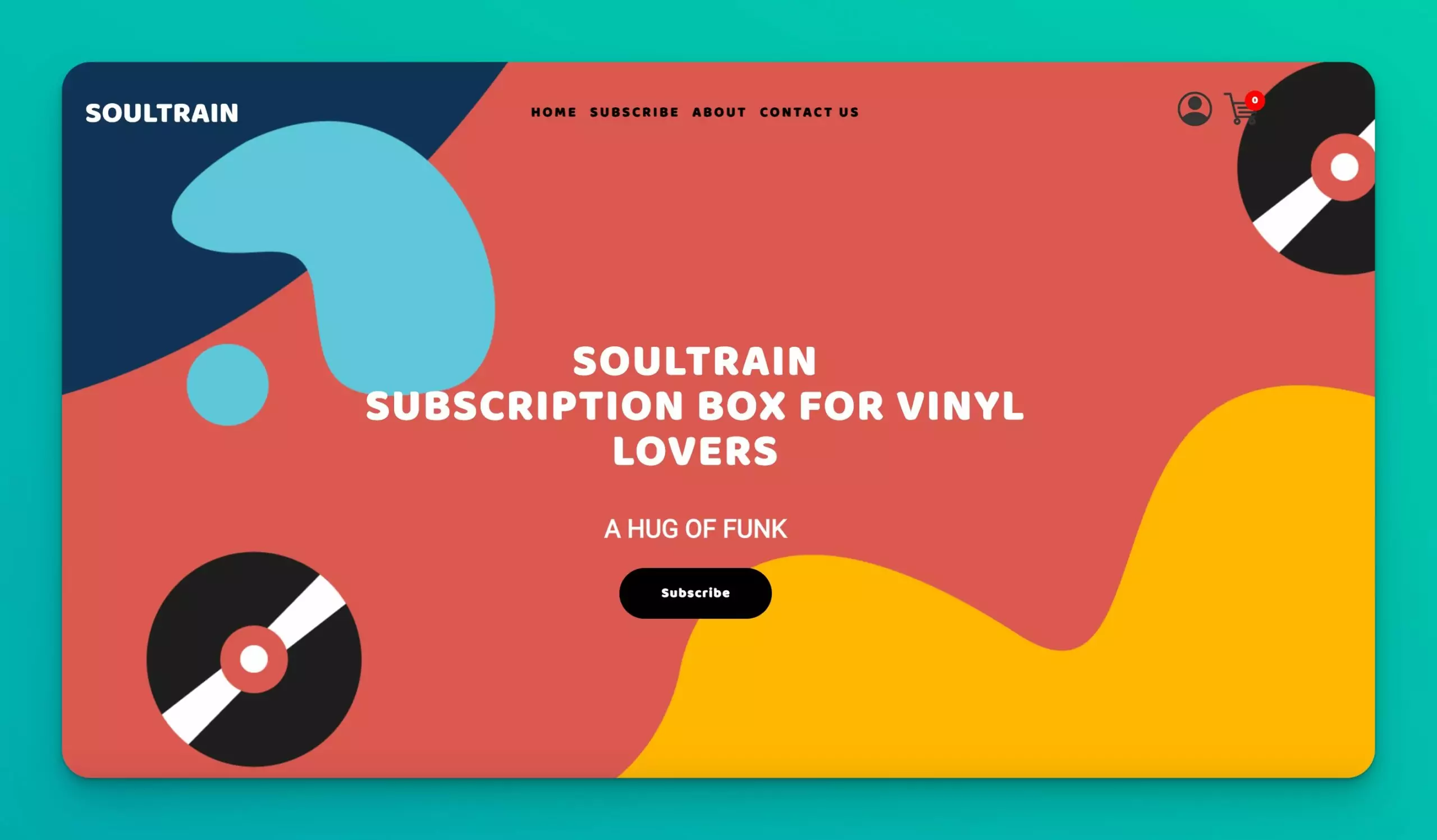
🚚 Establish your shipping and fulfillment
Shipping and fulfillment are important parts of your subscription box service. Together, they refer to the process by which your subscription boxes are assembled and shipped from the warehouse – or your garage – to your subscribers’ doors.
For subscribers, it’s about the process of managing, tracking, and receiving their orders.
Transparent, two-way communication is vital here, as is making sure all packages are shipped both on time and in good condition.
When it comes to shipping, it’s also important to think about how you process returns. If a customer needs to return an item, make sure you have a clear, easy-to-follow return policy.
You should also consider how it might affect your customers’ carts.
For example, if they spend over a certain amount, will their shipping be free? Ensure you have dynamic shipping rules in place to handle these changes effectively.
Fulfillment involves the stage between receiving your products from suppliers and packing them into boxes before they’re handed off for shipping. It’s a process that can either be done in-house or get outsourced:
In-house
This would mean you do everything yourself. For many subscription services or products, this is useful when starting out.
You’ll get an in-depth look at every aspect of the process and directly oversee quality control while achieving significant cost savings.
Outsourcing
Outsourcing means you would pay someone else to handle your fulfillment.
Fulfillment comes with its fair share of challenges and costs, such as liability insurance, cleaning the warehouse space, paying for labor, training employees, and ensuring quality control.
If you manage to find a good shipping partner that you can trust, it’s a worthwhile investment for your subscription business model.
Here’s some more information on the fulfillment process, with a list of questions to ask potential fulfillment partners to save you time and help ensure they’re up to par.
💰 Set up your billing process
The last part of this step is making sure your subscription billing framework is set up correctly.
Subscription billing is a process that allows merchants to automatically charge subscribers a pre-approved amount at certain intervals in return for their goods and services.
A good subscription billing framework is optimized to ensure every aspect of the customer journey related to transactions works as efficiently as possible. These aspects include:
- The checkout process: This should be as smooth and simple as possible to ensure potential subscribers check out.
- Account management: You need to ensure every aspect of each financial transaction is customer-friendly and that subscribers have a good experience making payments.
- Analytics: Often built into your payment provider, this can provide you with data pertaining to your revenue and all the payments that have been made to you.
- Revenue recognition: This is how your revenue is recorded and reported. The goal here is to ensure your revenue matches the number of deliveries of your subscription boxes.
- Payment processor choice: You need to choose a payment processor that is easy for your customers to use so that they complete their payments hassle-free.
- Custom billing cycles: If your customers prefer being billed quarterly rather than monthly, then you need the flexibility to set this accordingly.
What happens if your customers don’t pay their subscriptions on time?
That’s where dunning sequences come in. They automatically remind customers to make their payments, saving you from manually chasing down overdue accounts.
For example, Nail Mail, a subscription service for nail art boxes, cut their admin time in half after switching from Wix to Subbly.
Founder Gaynor McCann now spends 70% of her time running the business and only 30% on administrative tasks—compared to the opposite before the switch.
Here’s how Subbly allows you to select from a wide range of payment processors:
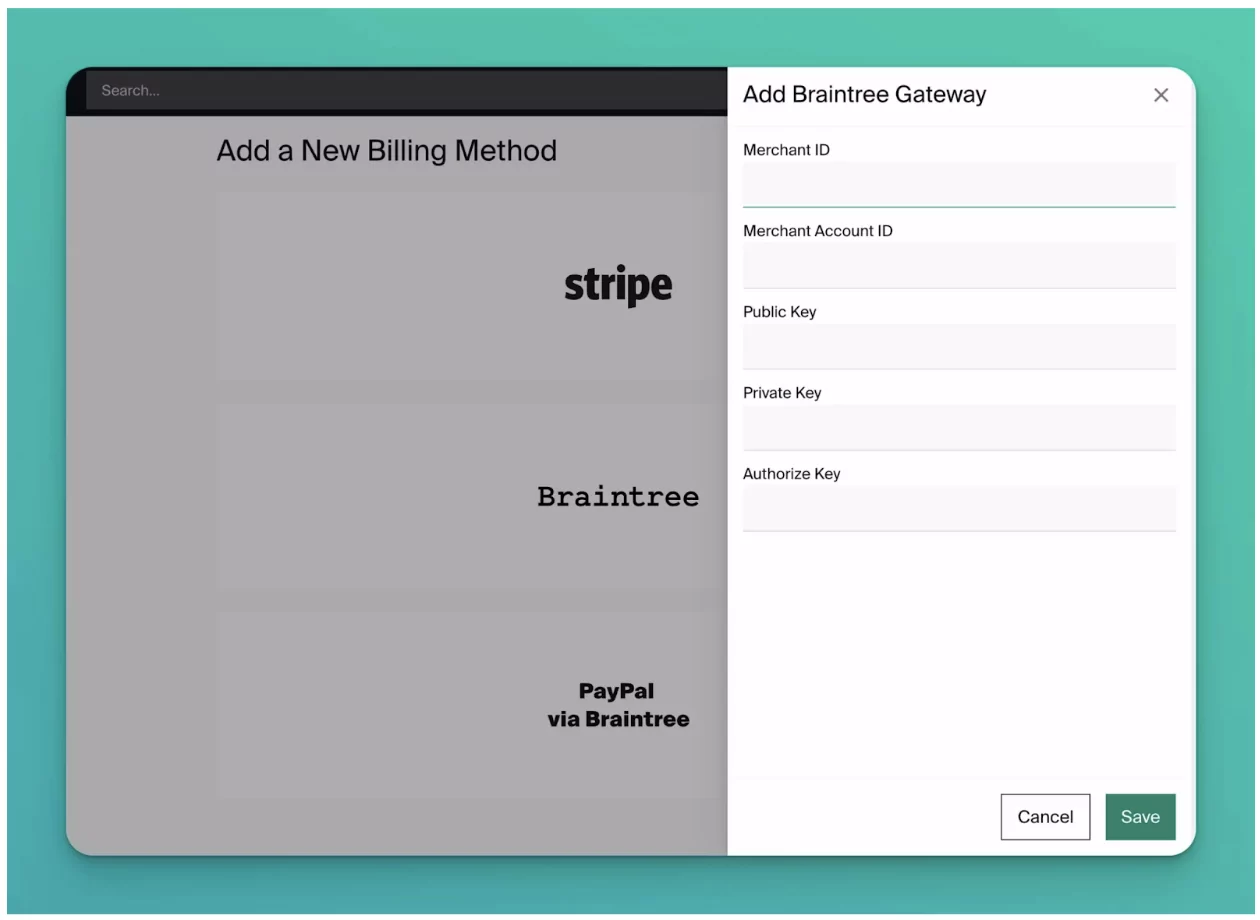
Subbly allows you to select from a wide range of payment processors.
💡 Top Tip
For the most flexibility, we recommend offering multiple payment gateways such as Stripe, PayPal, and Braintree.
Step 4: Market and Promote Your Box
The quick version: get creative with your marketing and promotion initiatives – the more engagement you can stoke before you launch, the better!
Now, it’s time to start thinking about marketing and promotion. This is key to customer acquisition, both in the initial stages and as your business grows.
The quick version: Get creative with your marketing and promotion initiatives – the more engagement you can stoke before you launch, the better!
Now, it’s time to start thinking about marketing and promotion. This is key to customer acquisition, both in the initial stages and as your business grows.
As a new business, there’s a lot to take into account before you launch, particularly when it comes to demonstrating sales intent and building an integrated subscription box business model.
There are a few things to consider at this point:
- How do you attract new customers? How do you get potential customers excited to start a subscription?
- What is your approach to marketing and promotion going to be? Will you use social media marketing campaigns, a unique landing page to build up your email list, or an excellent unboxing experience?
The philosophy that should guide your approach is summed up beautifully by this quote:
Want to learn more? We have several guides to help you market your subscription box, including:
- Subscription Marketing Strategy: A Complete Guide
- Subscription box email marketing: a complete guide
- 12 Ways To Grow & Market Your Subscription Box
- Top 14 SMS Marketing Ways to Grow Your Subscription Business
- How to gain hundreds of subscribers with email marketing
Step 5: Launch Your Box
The quick version: Counting down to liftoff is super exciting. Once you’ve launched, retention becomes of paramount importance, as does keeping a keen eye on your metrics across the board.
Once you’ve launched your subscription box or other model, other factors come into play. Are you ready to take the leap?
🗓️ Preparing your pre-launch
The most basic form of a successful pre-launch campaign consists of three main elements:
- Creating a distinctive landing page: Keep your copy simple and CTAs clear. Ensure you include high-quality photos of your products and what the final box looks like to entice potential customers.
- Driving traffic to that landing page: Use social media channels and influencer marketing to start driving people to your website. You can also include links to your website in marketing emails to drive traffic to your site.
- Growing and nurturing your email list: Set up automated campaigns interspersed with some personalized outreach.
As your pre-launch campaign winds down, don’t lose momentum. Create urgency, keep posting on social media platforms, thank those who helped you, and make any last-minute tweaks.
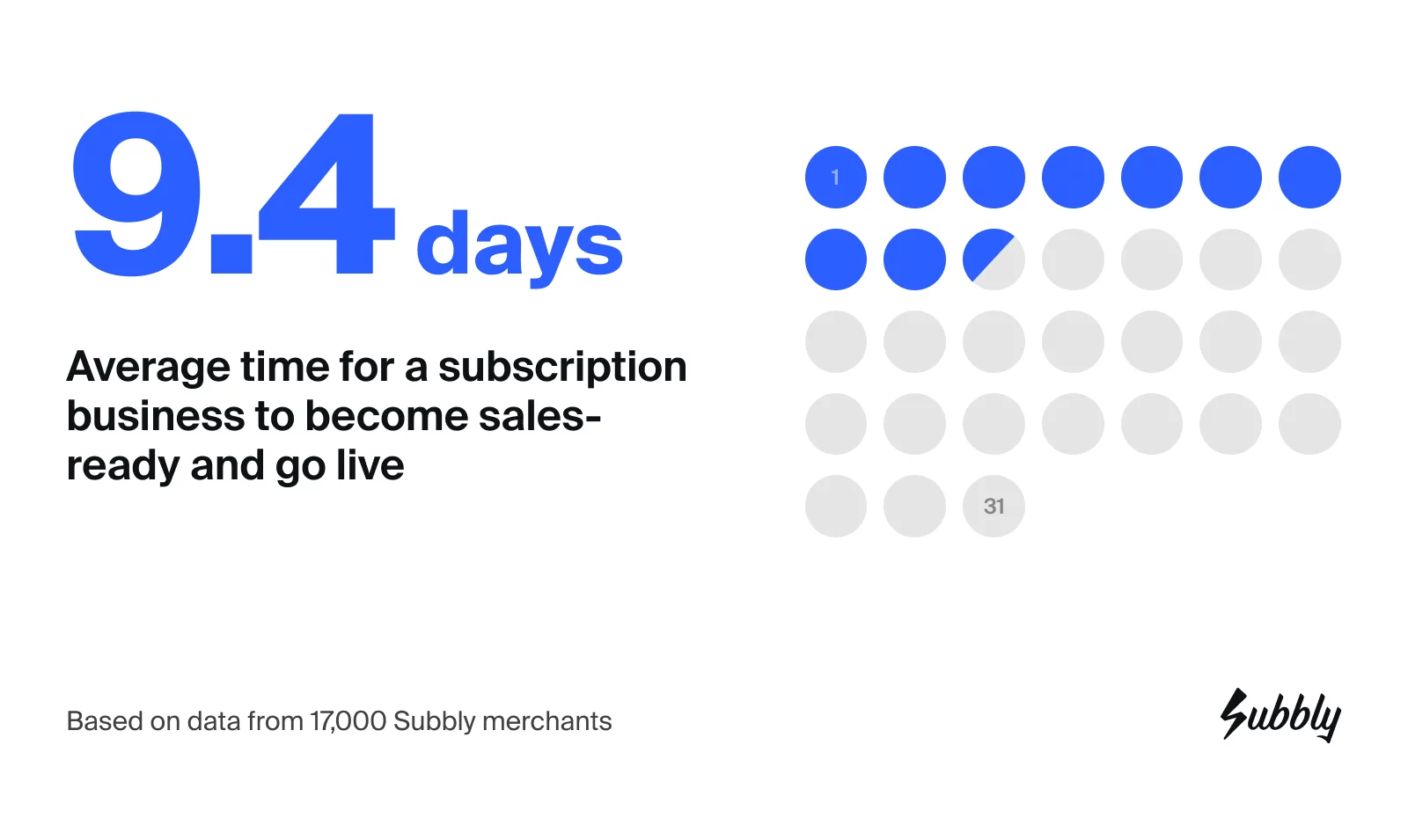
📊 Looking ahead: Metrics, forecasting, and reducing churn
Tracking your metrics is crucial once your subscription box service has been launched.
What metrics and KPIs should you be tracking?
In a subscription context, some metrics are more important than others, and you probably don’t have time to track them all. A selective approach to subscription business analytics is key.
Subbly’s analytics dashboard is key to making sure you don’t miss a beat:

A clear dashboard is key to making sure you don’t miss a beat!
The most important subscription business metrics are those that indicate that you’re delighting your customers and that they’re converting fast, not churning, and becoming cheaper to attract and retain over time.
You’ll find all of these metrics on Subbly:
- Average Revenue Per Subscriber (ARPS): This is the total revenue divided by the total number of subscribers. Although this is similar to the more commonly used average revenue per user (ARPU), we feel it is important to make the distinction between subscribers and users.
- Monthly Recurring Revenue (MRR): This is ARPU (calculated over one month) multiplied by the total subscribers (active in the same month).
- Customer Acquisition Cost (CAC): Divide the cost of sales plus the cost of marketing by the number of new subscribers in a specific time frame.
- Churn rate: This is the total cancellations in a given period divided by the number of subscribers at the beginning of the period, multiplied by 100 (percentage conversion).
- Lifetime value (LTV): The total revenue a business can expect to earn from a single subscriber over the entire duration of their relationship with the company, calculated by multiplying ARPU by the average subscriber lifespan.
Learn more about metrics with our handy guides
- ARPU (Average Revenue Per User): In this piece, we’ll discuss what your ARPU is, why it matters in a subscription business model context, and how to calculate it properly to drive results.
- MRR (Monthly Recurring Revenue): Growth rate, average sales price, and productivity are also important metrics, the amount of MRR is the one that really matters to subscription businesses. Read this to find out why.
- CAC (Customer Acquisition Cost): From leveraging social media and guest posts to paid ads, the methods you choose to market your subscription business can send your CAC skyrocketing or plummeting. Here’s everything you need to know.
- Churn Rate: Minimizing churn is important because it’s much more sustainable, and cheaper, to retain current subscribers than to acquire new ones. Beyond sales figures, your churn rate is also a good indicator of how satisfied your subscribers are with your products.
Understanding revenue forecasting
The more data you collect and the more you optimize your offering accordingly, the better your results will be. This helps a lot when it comes to revenue forecasting. You’ll also need to calculate revenue recognition.
Both of these are quite complex topics that are important to take into account as your business grows over time. To understand this fully, read our full guide on revenue forecasting.
Conquer customer churn from early on
Churn is one of your biggest challenges if you want to follow a subscription business model successfully. Your churn rate is the number of subscribers you lose over a defined period of time.
This typically occurs in two ways:
- Voluntary churn: Subscribers who make the active choice to unsubscribe from your offering.
- Involuntary churn: Customers whose subscriptions end due to issues like declined credit cards or other circumstances beyond their control.
Losing a few subscribers might not seem like a big deal at first, but over time, it can really add up. This was the case with Boddle Box, a subscription service that sends bath bombs for kids.
While using Wix, they faced high voluntary churn, with customers canceling their subscriptions.
After switching to Subbly, they introduced options for customers to downgrade or pause their subscriptions.
This helped them retain customers during critical moments instead of losing them entirely.
In general, if you want to reduce voluntary churn, reach out to your subscribers proactively (ideally personally) and find out what went wrong.
At a minimum, set up surveys and automated emails asking them for feedback so you can keep your finger on the pulse.
To reduce involuntary churn, assess your dunning process and associated communication flows and determine where to make the process smoother and easier to interact with.
The earlier you implement processes designed to reduce subscription churn, the easier it’ll be to achieve.
🤝 Top strategies for customer retention
It’s significantly cheaper to retain a customer than to acquire a new one. There are many subscriber retention strategies you can try out to keep your customers coming back for more boxes. Some of them include:
- Creating automated offers that trigger at specified subscriber drop-off points.
- Communicating during and beyond the buying journey to maximize engagement.
- Analyzing common points from cancellation surveys and adapting your offer accordingly.
- Offering rewards and downgrade options to lower the subscription cost.
- Making sure all the crucial parts of the billing process are communicated well in advance.
- Credit the customer’s account with a balance after a certain amount of time has passed.
- Add free products to orders that exceed a specified total.
- Send an SMS promoting a one-time product offer at a discounted price.
What comes next?
Congratulations! You’ve made it to the end of our blueprint for how to start a subscription business.
Each of the steps outlined above is easy when you use Subbly. Thousands of businesses are using our platform to run subscription box businesses.
With our tool, you don’t need to try and do it all yourself. Subbly is a subscription-first platform with everything you need to get your business started – no plugins necessary.
If you’d like to try Subbly out for yourself, sign up for a free trial. We’re excited to join you on your journey to subscription box success!
Frequently Asked Questions
If you’re still feeling uncertain about running your own subscription box business, then have a look at the answers to these frequently asked questions:
Do subscription boxes make money?
Subscription boxes have a profit margin of between 40-60%. This is in contrast to general small businesses, which have an average profit margin of between 7-10%.
This means entrepreneurs with subscription business models have the potential to be significantly more profitable compared to other business models, such as one-off purchases.
How much does it cost to start a subscription box business?
The startup costs for a subscription box business can vary widely depending on the type of product you’re offering.
For instance, if you’re starting a meal prep subscription, you’ll need to invest in food ingredients, refrigeration, packaging, and shipping, which can be quite expensive.
On the other hand, if you’re launching a subscription for greeting cards, your initial costs will mainly involve design, printing, and basic packaging, making it much more affordable.
However, on average, starting a successful subscription box business will cost you between $5,000 and $50,000.
How to start a subscription business?
Starting your own subscription box company involves five key steps.
Each section of the article provided a “quick version,” so putting them together offers a clear summary of how to get started:
- Choose your subscription box: Your idea is the foundation of your business.
- Start your planning: Leave no stone unturned when it comes to planning.
- Set up your operational framework: Start things off on the right foot when it comes to the e-commerce platform you choose, website creation, shipping, and billing.
- Market and promote your box: Get creative with your marketing and promotion initiatives – the more engagement you can stoke before you launch, the better!
- Launch your box: Counting down to liftoff is super exciting. Once you’ve launched, retention becomes of paramount importance, as does keeping a keen eye on your metrics across the board.
How do I create a subscription service?
The most important decision you will make when pursuing a subscription business model is choosing the right niche and target audience.
From there, you’ll need to set up a reliable operational system, including selecting an e-commerce platform, managing inventory, and ensuring smooth payment processing.
Make sure you choose an all-in-one e-commerce platform, such as Subbly, so that you launch quickly and start building your business.
How do I start my own subscription service?
It all hinges on a good idea. If you can come up with a product or service that customers would love to receive regularly, then you have the foundation for a successful subscription business.
From there, you’ll need to conduct thorough market research, develop a business plan, and set up the logistics—such as sourcing products, choosing an e-commerce platform, and figuring out shipping.
If you want this to run smoothly, make sure you partner with a platform that offers all the features that you’re looking for.
How profitable is a subscription box business?
Many subscription businesses have made massive profits from their subscription services or products. Here are some examples:
- Framed By Sarah: Their founder, Sarah Williams, says she’s made over $1,000,000 from her subscription box business.
- Birchbox: Founded by Katia Beauchamp and Hayley Barna, Birchbox grew quickly from a small investment to millions in annual revenue.
- Dollar Shave Club: Founded by Michael Dubin, Dollar Shave Club revolutionized the razor market with its replenishment subscriptions, leading to a $1 billion acquisition by Unilever in 2016.
This shows that, by pursuing subscription box business models, both you and your investors stand to gain a lot.

